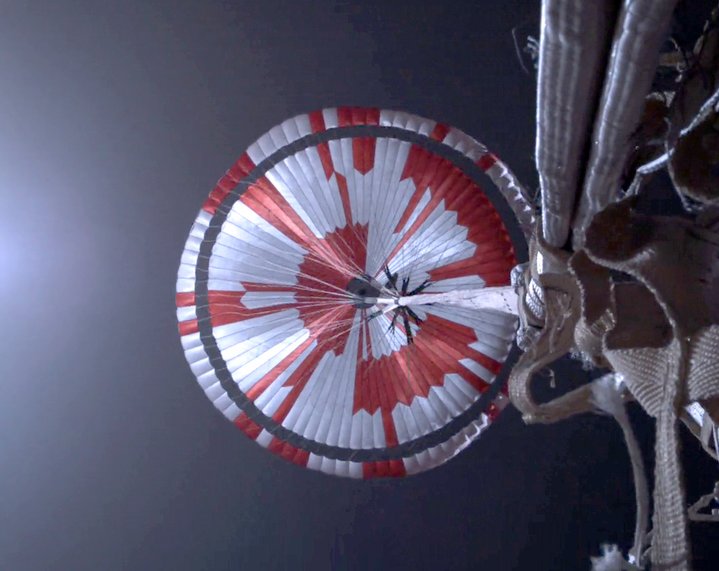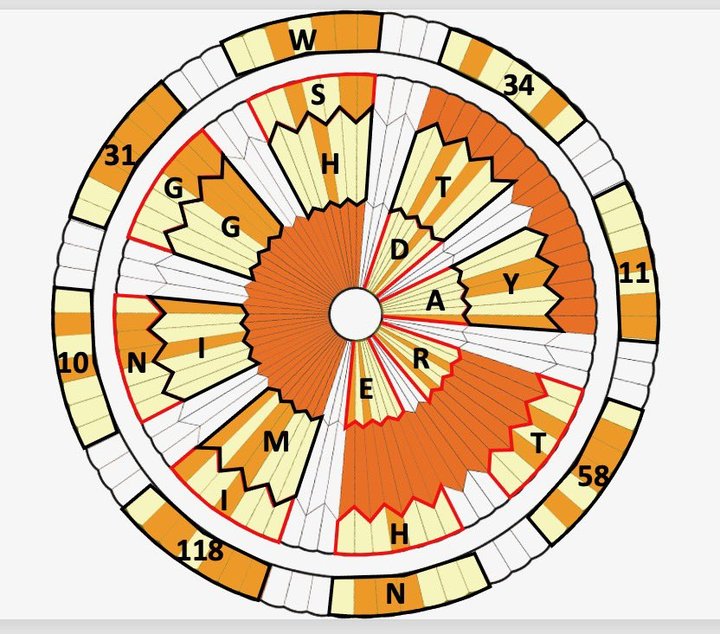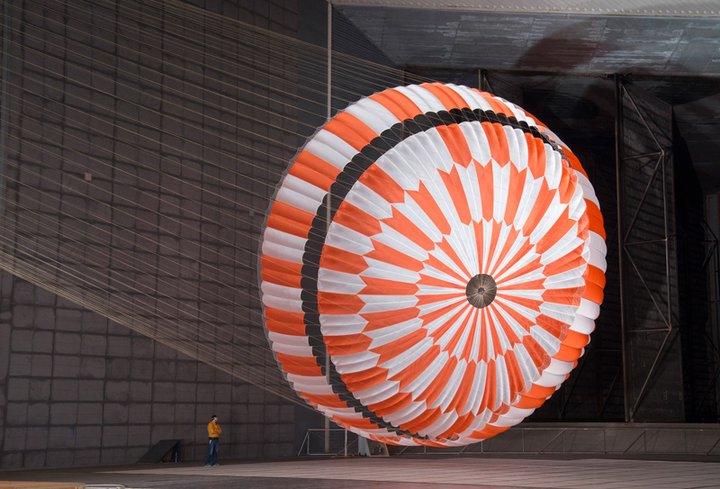“Far better it is to dare mighty things, to win glorious triumphs, even though checkered by failure, than to take rank with those poor spirits who neither enjoy much nor suffer much, because they live in the gray twilight that knows not victory nor defeat.” (Theodore Roosevelt, 1899)

All photos: NASA/JPL.
That’s the parachute that slowed the Mars Perseverance rover down from supersonic to subsonic velocities as it entered the thin atmosphere of the planet. Unlike previous missions, this time NASA was determined to record every step of the nail-biting seven-minute descent. For the critical parachute deployment, it had two upward-looking cameras videoing the process, both to acquire data that will be useful on future missions and, well, what great PR! This 1:21 minute video has been shared countless times—here it is again:
If you view to the end of this clip, Al Chen, Perseverance’s EDL (Entry, Descent and Landing) Lead, comments on the red and white pattern of the ‘chute, saying how useful it is to track features of the parachute as it inflates. He then adds, cryptically, “We hope our efforts and engineering can inspire others. Sometimes we leave messages in our work for you to find for that purpose. So we invite you all to give it a shot and show your work.”
It took French computer science student Maxence Abela just six hours to figure it out. In fact it’s pretty simple once you know the system. Note the canopy pattern is divided into four rings, the inner three of which have 80 segments (“gores” in parachutese) each. If you assume that red is 1 and white is 0, the innermost ring reads:
0000000100 0000000001 0000010010 0000000101 0001111111 1111111111 111111111 1111111111
I’ve added spaces between each ten characters because it’s binary code in eight blocks. So the first block has seven zeros followed by a one followed by two zeros, which translates as 4 (reading right to left: 0*1 + 0*2 + 1*4 + 0*5… = 4). D is the fourth letter of the alphabet, The 4 is followed by 1, 18 and 5 in binary, i.e. A, R and E, to spell out DARE. Taken together, the three inner rings read, DARE MIGHTY THINGS, which, if you’ve been watching NASA’s feed, you’ll know is the motto written on the walls of the Perseverance “war room.”

The outer ring took a bit more deciphering, but someone soon figured it out as 34°11’58” N 118°10’31” W, latitude and longitude of the Jet Propulsion Laboratory (headquarters of the Perseverance team) in Pasadena. Adam Steltzner, Perseverance’s Chief Engineer, posted this image right after the code had been cracked:

Design, manufacture and testing of the huge—70ft diameter—parachute were vital steps to enable Perseverance to land safely. In less than two minutes, it decelerated the craft from supersonic velocity (940 mph) to under 200 mph. To be sure that the ‘chute wouldn’t tear on deployment (as several other designs had done in wind tunnel tests), the one used for Perseverance was tested repeatedly in the world’s largest wind tunnel at NASA-Ames in Mountain View.

2017 wind tunnel test. Note human figure for scale.
The parachute that brought Perseverance down safely to Mars was manufactured by Heathcoat Fabrics in Tiverton, Devon, England, a provincial town I know well—my Uncle Ted was the Barclay’s Bank manager there during the 1950s. It was nice to see one contribution of the huge international effort that brought Perseverance safely to Mars, ready to start her primary mission: looking for signs of ancient life.
This is how the parachute ended up on the surface:

Enhanced) photo taken on February 19 by NASA’s Mars Reconnaissance Orbiter High Resolution Imaging Experiment (HiRISE) camera.
CLICK TO MANAGE